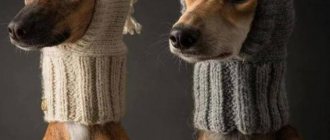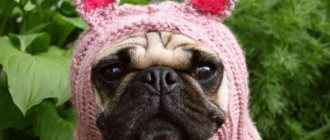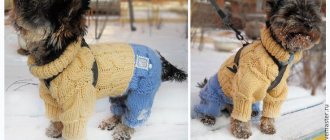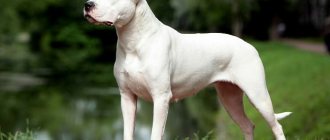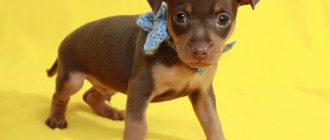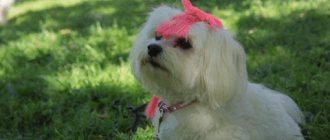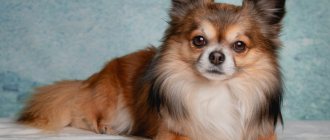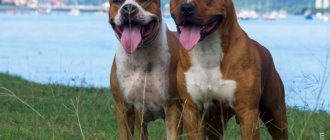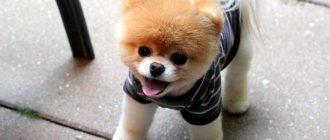If you are the happy owner of a terrier, then you, of course, know the cheerful and energetic disposition of these miniature dogs, which seem to be created for long walks and games.
However, like any breed, Toys have characteristics that should be taken into account. In particular, the smooth, short fur of these dogs is completely devoid of undercoat, which is why even on a fairly warm day the toy terrier can easily get hypothermia.
What can we say about the harsh Russian winters, snowstorms, rain? But why not cancel your little one’s walks for nine months of the year? Fortunately, there is a solution - special clothing for dogs.
Patterns and knitting patterns for clothes for small dogs: patterns for beginners with descriptions
Loop calculation
It is recommended to calculate knitting loops yourself, rather than using the calculation suggested in the instructions. Everything is explained by individuality - each craftswoman has her own thread tension force, so the fabric turns out to be either looser or denser. It follows that the number of loops for the fabric will have to be dialed in accordance with the resulting sample.
To knit it, it is recommended to cast on 20-30 loops and knit 10 cm in length with the pattern that will be formed in the main product. Next, the loops are closed and the thread is broken. The resulting sample is washed with the addition of a small amount of powder by hand and dried by laying it on a towel.
Then you need to measure the width and length of the product. Divide the obtained values by the number of stitches cast on and the number of rows, respectively. From here the knitting density is calculated.
In our case, there are 2.5 stitches and 4 rows per 1 cm.
Types of yarn for knitting.
Considering the tendency of toys to exhibit allergic reactions, you should be especially careful when choosing yarn. Your pet needs to knit things from natural yarn:
- cotton and linen. Eco-friendly, grown without pesticides, and dyed using natural dyes, cotton and linen yarns are durable and dry quickly after absorbing moisture. If you are thinking about how to knit a sweater for a toy terrier for walks in spring and autumn, then cotton or linen threads will do just fine.
- silk (natural or artificial). Summer versions of dog clothes made of natural silk will allow the dog to dress up on the street, but the skin will breathe and will not overheat. Artificial silk in its pure form is not used to create a new item, but is added to cotton or linen.
- wool A woolen sweater, jacket or overalls will be appropriate in winter, since wool is characterized by elasticity and lightness. Comfort for the pet is ensured by adding plant or artificial fiber to the product.
- angora wool. Products made from Angora wool in its pure form are not suitable for toy terriers. When knitting, be sure to add a thread of merino wool or acrylic fiber.
- merino wool. Yarn is very expensive, so a pure merino wool product can cost you a pretty penny. To make a toy item cheaper, look for yarn that contains another fiber. But even despite the presence of various additional threads in merino wool, today, clothes made from such yarn are the warmest and most practical for toy terriers.
- camel hair. To make your pet comfortable in things made from this type of wool, take soft yarn.
- mohair. Beautiful yarn of various colors will allow you to intelligently combine and create unique products. And the fluffiness of mohair gives things an extra zest.
- cashmere If you are a fan of this yarn, keep in mind that cashmere is not suitable for knitting dog clothes because it is not wear-resistant and washable.
- viscose. By combining viscose with cotton or linen thread, you can knit a lot of things for your beloved dog.
- fancy yarn (boucle, ribbon thread, etc.) is used to create stylish little things.
Knitted clothes for a toy terrier.
You can knit this terrier from threads of yarn:
- blanket.
- sleeveless vest/vest.
- sweater, jacket.
- overalls.
- Italian greyhound.
- booties for the home.
- hats and caps.
Comfortable boots for dogs
This part of the master class with a description will help needlewomen learn how to knit boots for their pets.
Knitted shoes for dogs are very comfortable to wear, as they do not rub anywhere.
In order for the product to last longer, you should listen to our advice:
- Sew a thick insole from the inside of the boot;
- Make the sole from impermeable, rough fabric. Make the remaining parts with knitting needles, picking up loops along the edge of the sole;
- To prevent the claws from resting on the toe of the boot, cover it with a strip of leather or nylon;
- You can use any style of knitting, but remember that the loops should not be airy, and the threads should be strong and dense. Thanks to such shoes, the dog's paws will always be warm, and he will never get sick!
Related article: Simple and beautiful knitting pattern
DIY knitted clothes for toy terriers.
For craftswomen who delight their household with their knitted products, you can skip the preparatory stages (they already know everything). But for those who want to try to create clothes for a pet with their own hands, you should prepare by carefully studying and following our tips on knitting/crocheting for a toy terrier.
Taking measurements for knitted clothes.
We arm ourselves with a measuring tape, pen and paper to write down the measurements taken.
- We call the toy terrier to us and give the command “Sit!”
- measure the circumference of the neck. If your pet dodges you, then to take this measurement, you can measure the collar.
- The following measurements are taken while the dog is standing.
- The length of the desired product is measured from the place where the collar is on the dog to the tail. If you want the dog's butt to be visible from under the thing, then the distance will be less.
- behind the front paws we measure the circumference of the chest.
- The length of the sleeve is measured according to the dog’s leg, and then adjusted during the knitting process.
Cute jumpsuit
This wonderful warm jumpsuit is suitable for winter and autumn.
Necessary materials for work:
- 100 grams of plain wool yarn;
- 10 grams of threads of bright colors;
- knitting needles No. 2.5.
The following measurements were used for this work:
- back - 28 cm;
- neck circumference - 21 cm;
- chest - 35 cm;
- girth of the front paw - 11 cm;
- hind leg - 15 cm.
The scheme will not present any difficulties, suitable for beginners:
You should start working with a collar with a lapel. To do this, cast on 70 loops of the main yarn and make a 1x1 rib for four rows. Then knit 4 more rows of yarn of other colors. Return to the main yarn, always using the same method of working - 1x1 rib. Now it's the turn of the back and belly.
Knit each part from 2 different balls at the same time so that they all come out uniform in length.
In the first row, add six loops and knit in this order: edge, yarn over, 11 loops with 1×1 rib, then 28 loops from the pattern according to the diagram, again 11 loops with elastic, yarn over, edge. In the next row, knit the yarn over with crossed loops into an elastic pattern. Continue knitting according to the pattern. It is worth remembering that in every second row you need to add a loop next to the edge loop on both sides. Include the added loops in the elastic pattern. Make armholes. The back can be decorated by sewing different stripes in the center of the diamond.
Related article: How to sew a swimsuit: tips and types of seams
To work on the belly in the first row, add 15 loops, yarn over through one or two loops. Second row with an elastic band, in every second row add a loop on both sides next to the edge stitch. Knit to the armhole. The armhole is made in this way: in the 12th row, close off three loops at the beginning and end of the back and belly. Make 11 rows. At the end, cast on three air loops. After 14 cm from the collar, close the loops.
Sleeves and pants are knitted separately from the main fabric. For the sleeves, cast on 30 stitches in the main color and knit with a 2×2 rib. After three rows, switch to red and in each row add loops from both edges. Close the loops after 4 centimeters. Sew the belly and back to the armholes, sew in the sleeves and sides of the sleeves, sew. Knit two strips of 51 loops with an elastic band 1 through 1, 1.5 cm wide. Sew to the sides of the back, not reaching the bottom of the back 5.5 centimeters. Sew the trouser legs to the armholes.
We knit for a toy terrier. Scheme.
First, read the general recommendations that are suitable for any type of clothing.
the number of loops is calculated depending on the measurements of the animal. To avoid making a mistake with the quantity, knit a sample of the selected pattern to use it to calculate how many loops you will need.
if you are going to knit a sweater, then knit each detail separately (back, sleeve, chest, collar). And then sew them together.
- For making a vest, the knitting method in the round is suitable.
- The blanket should be knitted with a continuous thread, trying not to be interrupted.
Use the step-by-step knitting instructions to knit a sweater for your Toy Terrier.
- Based on the volume of the chest, we cast on loops. The approximate number for a toy terrier is 88 loops.
- Start knitting from the collar area. If your toy terrier is a mini, then reduce the number of loops by 20 pieces.
- Having cast on the loops, start knitting with a regular elastic band about four centimeters.
- Next, divide the loops into five identical parts and knit the first two with an elastic band, then the middle part with the stockinette stitch, and again two parts with an elastic band.
- add the number of loops to the chest circumference.
- after about 6-7 centimeters we begin to leave slits for the paws.
- having reached the end of the product (we are guided by the length of the item). We transfer the loops to different knitting needles and knit the back stitch with stockinette stitch.
- closer to the end of the item, begin to narrow the sweater so that it does not hang on it like a shapeless rag.
- We tie an elastic band around the edge of the sweater.
- The sweater should be sewn using edge loops.
A sweater for a toy terrier is crocheted using the same principle.
Stages of creation
To make a knitted jumpsuit for a dog, you need to start with mathematical calculations. Such a base will allow you to create a knitted item without a single seam and exactly in size, which will give it comfort and aesthetics.
Taking measurements
In order for knitted clothes to fit comfortably and beautifully, you will need to take 8 measurements from the dog:
- ОШ – neck circumference;
- OG – chest circumference;
- VG – chest height from the base of the neck;
- SH – the width of the chest between the dog’s front legs;
- Diz – the length of the product from neck to tail;
- OT – waist circumference;
- Ogol - head circumference for the hood;
- ШШ – step width, i.e. the distance between the dog's front and back legs.
Important! Boys have a shorter step width because... measured to the dog’s “private” area. This is done to avoid damage to clothes while relieving yourself while walking.
To get a knitted overall for a Yorkie, I took the dog’s average measurements, given in centimeters:
- OS – 25;
- OG – 34;
- VG – 10;
- SHG – 6;
- Diz – 26;
- OT – 32;
- Ogol – 28;
- ShSh – for a boy 11.
For a girl dog, the step width can be extended to 16 cm; for a boy’s mini Yorkie, I took the above measurements.
Raglan calculation
The first step is to calculate the knitting density. The thickness and weight of yarn differs for many people, so it is better to make an individual calculation for each dog. To do this, we make a knitted square of 10 by 10 cm and count how many loops and rows fall into 1 cm of the product.
In my case, there are 2.5 rows and 2.1 loops in 1 cm. We will round the loops to 2, which will not greatly affect the outcome, since a simple dog jumpsuit will be loose.
Having calculated the number of loops, I received the following initial data:
- Dog's back – 27;
- Breast – 6 + 6 (two strips) + 5 + 5 (overlap for buttons);
- Sleeves – 5 each;
- 4 raglan lines, 1 purl loop each;
- To achieve the desired size, 12 increases will be made at the raglan lines.
Important! Increases will be made by 2 at the raglan on the back and 1 at the raglan line on the sleeve in front of the chest. The width of the planks and overlap should remain unchanged.
Abbreviations used in the diagram:
- And, out. – purl loop;
- L, persons. – facial;
- Reg., r.l. – raglan;
- Etc. – increase;
- U – decrease;
- P., pet. - a loop;
- R., r-d - row.
Having received all the initial data, we begin knitting.
Note: we will knit the raglan line on the product with a purl stitch.
Step-by-step description of knitting a sweater for a pet
It is not necessary that the hand be full. To knit a simple sweater for a Chihuahua, some basic skills are enough. A pattern and knitting pattern for a simple sweater for a dog won’t even be useful. An elementary lesson will help you figure out how to knit a sweater for your pet.
Materials you will need:
- warm melange yarn;
- knitting needles No. 4;
- bobbin threads;
- scissors;
- needle.
For your information! Knitting begins with a collar with 1×1 or 2×2 rib. It should not be knitted too tightly so that it is easy to put on and take off. The average collar width for small dog breeds is 5 cm. After the end of the collar, the main part begins.
The main fabric is knitted in stockinette stitch. Starting from the third row, add 2 loops in each subsequent row. You need to add until the width of the product is equal to the circumference of the dog’s chest + 2 cm for allowances. At this stage, it is recommended to first try the sweater on your pet to make sure it is the right size. Next, knit 3 more rows without additions.
Knitting holes for paws
To make holes for the paws, you need to skip the required number of loops corresponding to the size. To do this, knit the first 3 cm, cover the next 6 cm, then knit to the second armhole. When a sleeve of the appropriate size is obtained, air loops are added and then knitted with a single piece of fabric. The edges are tied. You can use a hook for this.
Then, to narrow the product towards the bottom, you need to decrease 2 loops in every seventh row.
Important! As you knit, you need to regularly try on the product for the future owner.
When the length of the fabric is sufficient, you need to finish the product by knitting the edge with a 1x1 or 2x2 elastic band. To assemble the sweater, the edges are sewn together with threads.
A dog in a knitted sweater feels comfortable
Variety of warm clothes
Clothes for dogs can be casual or formal. There are many types of clothing:
- overalls;
- blanket;
- sweater or jumper;
- dress;
- panties.
A knitted suit will give your pet a unique appearance.
For your information! The easiest product to make is a cape. To knit it you do not need to have perfect technique. These clothes are suitable for cool spring or autumn. In winter, more thorough insulation is still required in the form of overalls or a set of pants and a jacket for a dog.
In addition to basic clothing, hats of various styles and dog shoes are popular among animals.
Yorkie feels cozy and warm in a knitted hat
When choosing a model, you should pay attention not only to beauty, but also to practicality:
- the ties must be of sufficient length so that they do not come undone during walks;
- clothing should not hinder the pet’s movements;
- the collar should fit freely under or on top of the product;
- The length of the sleeves and panties should be shortened, otherwise the lower edges will quickly wear out.
What to knit clothes for your pet from
When choosing yarn, you need to take into account the properties of the material, the particular conditions of washing and drying the finished product. The main synthetic fibers are:
- acrylic (PAN). If the yarn is of high quality, the items made from it are light, retain heat well, and practically do not shrink after washing;
- viscose. If the threads consist entirely of viscose, during wear such items do not hold their shape well and are stretched.
Note! Natural threads are hypoallergenic, but more difficult to care for. Products made from such yarn should be washed at low temperatures and dried without the use of heating devices.
The following types are distinguished:
- linen. Durable yarn. Things made from it are durable and of high quality, and are little susceptible to shrinkage after washing;
- cotton. Pleasant to the touch, quite durable, but not elastic. Cotton yarn is heavy;
- wool. The warmest yarn. But woolen items do not last long, they form pills and shrink heavily after washing.
